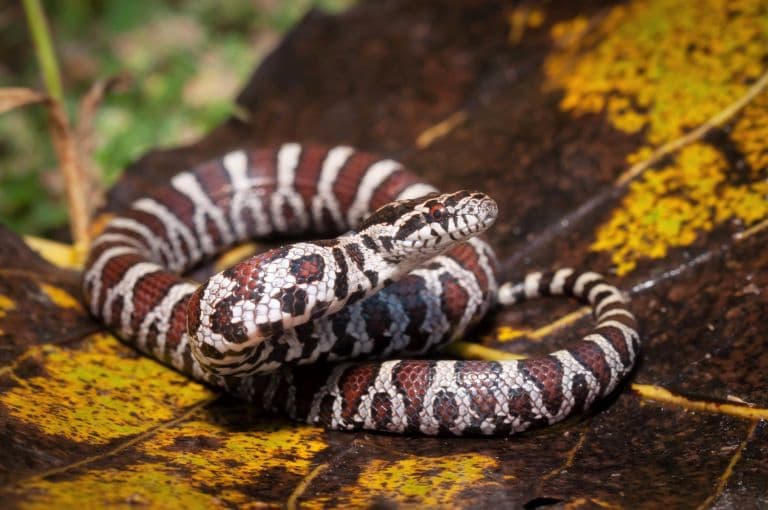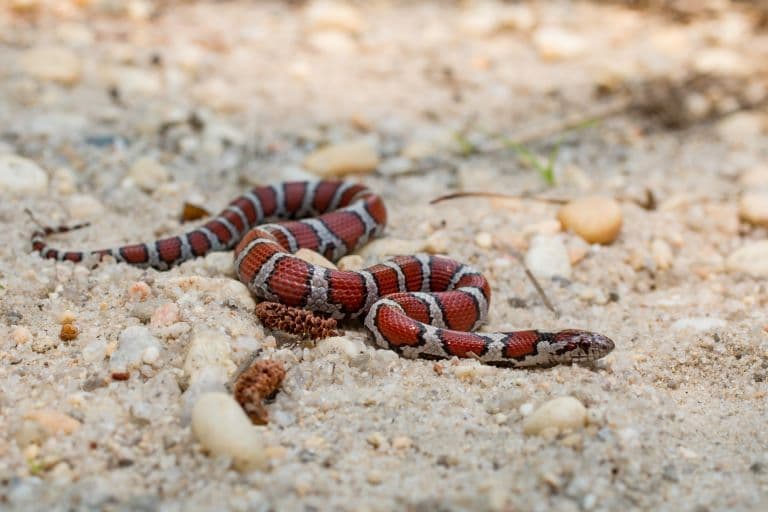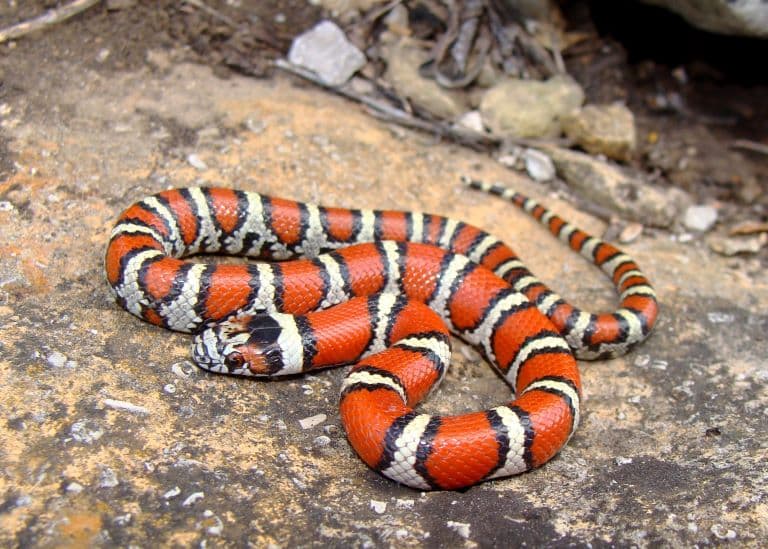Milk Snake Profile
Snakes are going out of fashion. Not since Alice Cooper have snakes routinely made it onto the stage at a mainstream music event, and it’s likely that 2003 was the last time a song about a snake topped the charts.
This was the year Kelis’ third studio album “Tasty” sneaked a curious and catchy tune in about a milk snake, that drew a mostly male audience into someone’s garden.

Milk Snake Facts Overview
| Habitat: | Forested or open woodland, swamps, prairie, farms, sandy areas. |
| Location: | The Americas, from Canada to Colombia |
| Lifespan: | 21 years in captivity |
| Size: | Up to 1.8 m (72”) long |
| Weight: | 750 to 1,400 g (1.65 to 3.09 lb) |
| Colour: | Orange-red with black or black and white bands |
| Diet: | Insects, lizards, other snakes, small mammals, eggs, frogs, fish |
| Predators: | Skunks, raccoons, dogs, cats, hawks and owls |
| Top Speed: | Fast |
| No. of Species: | 1 |
| Conservation Status: | Least Concern (IUCN) |
These kingsnakes draw a lot of attention due to their brightly coloured barring that makes them look significantly more toxic than they actually are.
They’re named for a strange myth involving cows and are often found in barns, among the variety of other habitats they do well in.
Overall, this is a pretty and adaptable snake that makes a decent pet as long as you don’t make it release discharge.
Interesting Milk Snake Facts
1. They’re kingsnakes
Snakes are notoriously varied in their colouration, and the milk snake is no exception.
This is a species of kingsnake with around 25 recognised subspecies spread out across the Americas (possibly 24 now, since the scarlet kingsnake was allocated its own species), and each has a somewhat different colour pattern.
Kingsnakes are constrictors, and named for their habit of eating other snakes, which the milk snake is also guilty of; this snake is known to feed on venomous species such as coral snakes and rattlesnakes, which brings a new level of intimidation to what is essentially a non-toxic animal.

2. They bring all the boys to the yard
Because of its pretty pattern, this is a very popular snake. It grows to a decent length, can’t kill you, and is remarkably hardy so relatively low maintenance, even in the UK.
Milk snakes aren’t typically aggressive, either, which makes them a cuddly option for a budding herpetologist and they only need feeding about once a week. 1
3. They’re like, “I’m red and I’m barred”
The striking pattern found on these snakes is a form of Batesian mimicry. They don’t try to camouflage themselves, instead, they try to bluff their way through life by taking on a similar pattern to a much more dangerous animal: the coral snake.
This mimicry works particularly in regions where the ranges of the coral snake and the milk snake overlap.
There are some dead giveaways, though, as the milk snake’s mimicry is far from perfect. While coral snakes have barring that involve red against yellow, milk snakes have bars of red against black, which belie a clumsiness reflected in the helpful saying:
“Red on yellow, kill a fellow. Red on black, friend of Jack”. 2

4. They don’t drink milk, but they’re found in barns
Ironically, “milk snake” also works as a verb, yet because there’s no venom in this one, it’s one of the more useless ways to spend a day.
But these snakes are named after the peculiar idea that they would sneak into barns and steal milk from cows. Half of this is true: milk snakes love barns.
The rest, presumably, comes from the wild imagination of farmers in the middle ages who would make up any old thing because they knew Google wasn’t going to be available for ages. There’s no truth in it whatsoever, and the snake would have little luck trying.
Other myths about these snakes are that they hold their own tails in their mouths and roll down hills and that they run in pairs. This species is almost entirely solitary, though will overwinter in brumation dens with multiple other snakes and team up for a quickie with another snake during mating season.
In reality, they only like barns because they’re dry and full of mice. 3 4
5. They won’t hurt you, they prefer discharge
As mentioned, this is a non-venomous snake but it’s not entirely defenceless against those who take it for granted.
Like many snakes, they have developed a particularly potent anal defence system that involves spraying gross glandular fluid all over themselves.
This discharge stinks, and when combined with the snake’s vibrating tail is enough to make many interferers lose interest.
6. They’re adaptable
Outside of barns, these snakes can be found pretty much all over the place.
Their ranking as Least Concern by the IUCN is a tribute to their adaptable nature, and they will happily live on farms, in rocky areas, coniferous or deciduous forests river bottoms, bogs, swamps, and meadows, among others.
As long as there are smaller animals to eat, you can be likely to find a milk snake, and this makes them important predators of various rodent species across the Americas.
Milk snakes normally hunt at night, and help keep the rodent population down and the ecosystem healthy.

7. Farming may cause them trouble
As with almost all species, though, there is potential for trouble down the road as animal agriculture swallows up more and more land.
Intensive farming separates populations with monocultures of plants or animals, pesticides alter the microflora ratios and kill off prey species, and certain pathogens are facilitated that can also have an effect.
For example, snake fungal disease is a new and emerging cause of decline in snake populations that is not yet fully understood.
Milk Snake Fact-File Summary
Scientific Classification
| Kingdom: | Animalia |
| Phylum: | Chordata |
| Class: | Reptilia |
| Order: | Squamata |
| Family: | Colubridae |
| Genus: | Lampropeltis |
| Species: | triangulum |
Fact Sources & References
- “Milk Snake”, Northampton Reptile Center.
- Marisa Baldine (2021), “The eastern milksnake isn’t venomous, it just wants you to think it is”, Chesapeake Bay Program.
- “Snake Myths”, Missouri Department of Conservation.
- Jessie Szalay (2016), “Facts About Milk Snakes”, Live Science.
